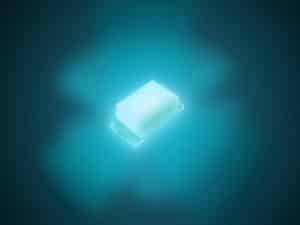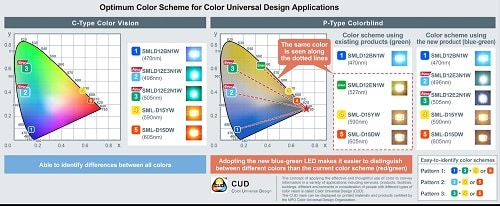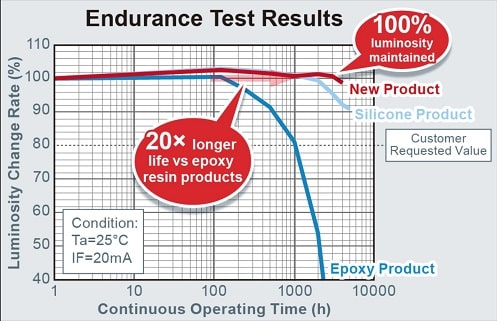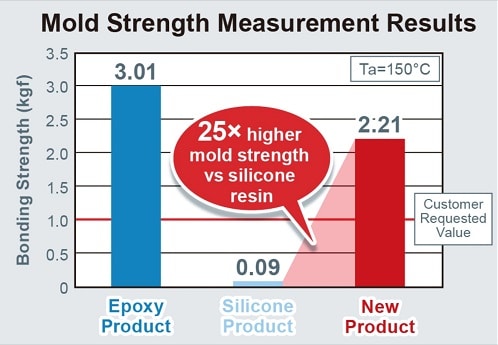Special wavelengths emitted by these LEDs provide help in distinguishing between two colours among people with color vision deficiency
 Colour is considered to be one of the most important means of communication and plays an important role in a variety of ways. However, approximately 200 million people with P-type and D-type colour deficiencies around the world find it difficult to distinguish between red and green, possibly resulting in information being inaccurately conveyed. Furthermore, since colour vision can vary from person to person, it is difficult to perceive how different people see certain colours, which can be very inconvenient and also problematic as other people may not notice this deficiency.
Colour is considered to be one of the most important means of communication and plays an important role in a variety of ways. However, approximately 200 million people with P-type and D-type colour deficiencies around the world find it difficult to distinguish between red and green, possibly resulting in information being inaccurately conveyed. Furthermore, since colour vision can vary from person to person, it is difficult to perceive how different people see certain colours, which can be very inconvenient and also problematic as other people may not notice this deficiency.
As a result, there is a growing need in the society to implement Color Universal Design that takes into account the various types of colour vision in order to deliver information accurately to as many people as possible.
Achieving that is the 1608-size high accuracy blue-green chip LEDs, SMLD12E2N1W and SMLD12E3N1W, which support the adoption of Color Universal Design (CUD) in a variety of applications, such as fire alarm system indicator lights, industrial equipment warning lamps and public transportation information displays.
These blue-green chip LEDs have special wavelengths and are thus ideal for implementing Color Universal Design in a wide range of devices, utilizing a vertically integrated production system from the element fabrication stage.
These LEDs are certified by the Japanese NPO (Non-Profit Organization), Color Universal Design Organization (hereafter referred to as CUDO) – making it possible to achieve colour schemes and designs that can be easily discernible by everyone, including those who cannot distinguish differences in colour.
Additionally, the application of a new resin significantly extends the LED lifetime while reducing the degradation of light intensity compared to conventional epoxy resins and improving the mould strength compared to the silicone resins while providing superior reliability.

Key Feature
Special wavelength blue-green LEDs – ideal for colour universal design applications – While there are a variety of devices that transmit information using red and green colours, adopting blue-green and orange or yellow will make it easier for people with P-type or D-type colour deficiency and difficulty to distinguish red and green colours. As such, the colour scheme is important for conveying information using LEDs.
By acquiring Color Universal Design certification for blue-green LEDs, it is possible for people with various types of colour vision and sensitivities to accurately identify colour patterns that include the use of blue LED chip (SMLD12BN1WT86, λD: 470nm) and warm colour LED chip (SML-D15YW, λD: 590nm; SML-D15DW, λD: 605nm).

Advantages of the SMLD12 Series
Adopts a new resin while ensuring high reliability
The SMLD12 series (SMLD12E2N1W and SMLD12E3N1W) utilises a new resin that improves on the following issues when using conventional epoxy and silicone resins, allowing worry-free use in devices requiring high reliability.
1) 20x longer life vs. epoxy resin
Luminous intensity is maintained even during endurance testing (25°C, IF=20mA, 1,000hrs), resulting in approx. 20x longer life at the same residual light intensity level vs epoxy resin products.

2) 25x higher mold strength compared to silicone resin
Adopting a new resin material which affects mountability improves mold strength by 25x compared to silicone resin products even at high temperatures (Ta=150°C). This minimises defects during mounting, achieving superior mountability.

Color Universal Design Application Examples
- Operating panel indicator lights for fire alarm systems, etc.
- Safety warning lamps in industrial equipment
- Information boards for public transportation facilities
- Parking lot occupancy (empty/full) indicator lamps
- Battery charge status indicators
- Display panels for hospital equipment (i.e. nurse calls) and more…
As per CUDO, differences in colour vision is classified into the following 5 types:

Availability: Now







